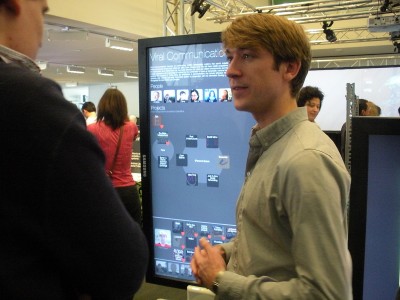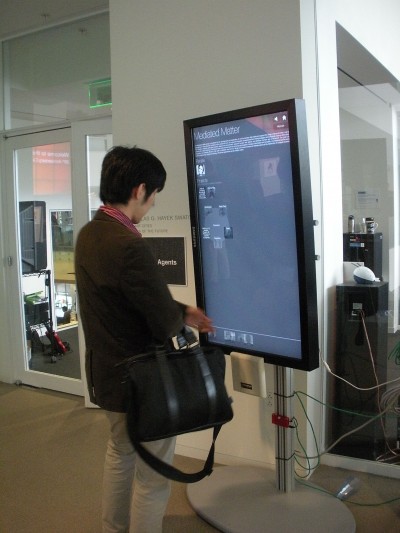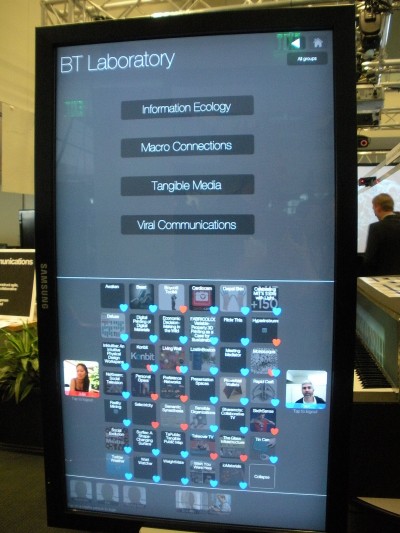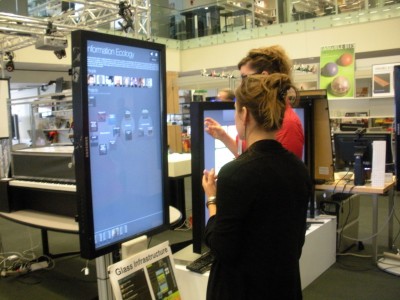Creating a dynamic social information system
by Matthew | 1 May 2012 3:23 pm
 [1]
[1]Photos courtesy MIT Media Lab
By Chaki Ng
Today, many public-facing organizations make a wealth of information about themselves available online, but provide little for visitors to interact with on-site. Recently, a group of researchers at the Massachusetts Institute of Technology (MIT) Media Lab designed and deployed an ‘intelligent’ signage system, referred to as Glass Infrastructure (GI), to enable groups of users to more easily interact with data and explore connections between people, projects and ideas.
The trend toward adding interactivity and computing to physical spaces has been due in part to the ease with which the places people work, live and travel can be networked, along with decreasing costs for the corresponding installed equipment. With these factors in mind, MIT’s GI is intended as a new type of visitor information kiosk for thematically organized places like stores, museums and research labs, extending websites into physical space.
The development of the project involved placing 30 touch-sensitive screens in strategic locations throughout MIT’s Media Lab complex. This system allows guests to learn about the lab’s research. It also recognizes them by their radio-frequency identification (RFID) tags and actively provides suggestions of projects and people they may be interested in throughout the building, offering background details and contextual information.
So, the kiosks are context-dependent, displaying information that relates not only to each screen’s location, but also to the user(s) standing in front of it. It is a novel—if not the first—application of such techniques to open, public displays.
In making the lab’s own website more ‘tangible,’ the initial purpose of the GI project was to develop an open information technology (IT) framework that could be used anywhere. It uses artificial intelligence (AI) and a text-understanding system to organize data thematically and update it automatically as new projects and connections arise, relying on the lab’s Project List Database (PLDB) as its source.
 [2]
[2]MIT Media Lab placed 30 kiosk screens throughout its complex, which could respond both to touch and to RFID tags.
Another goal was to harmonize the process of navigating a large touch screen using one’s fingers to that of navigating a physical space using one’s feet. This was inspired in part by the architecture of the new building the lab had moved into in December 2009, which is full of glass and open spaces.
Intelligent content
The main elements in the GI user experience are persistent representations of the central MIT research groups. When the user clicks on one project, the others already in view simply move aside in a new arrangement.
Within the Media Lab, each screen corresponds to nearby research groups, displaying them as its default view. This provides an entry point for users and a means to link projects to the physical space they inhabit. The user can then shift focus to less or more detail and see how concepts overlap.
In addition to using the PLDB’s project descriptions and lists of affiliated researchers and groups as its sources of data, the network uses the Open Mind Common Sense (OMCS) platform and its associated inference algorithm system, Divisi, to ensure a consistent base of background knowledge. OMCS can learn new words by discovering their relationships to existing concepts, without needing the system to be redesigned or rebuilt.
As mentioned, the system’s interaction and data model is designed to encourage the exploration of links between people and their projects. When two existing users log on to the same screen, for example, any items they have in common are highlighted. Indeed, one of the core social innovations of the GI user experience is the successful encouragement of sharing a single screen.
 [3]
[3]The kiosks were context-dependent, displaying information relating to the screens’ specific locations and the user(s) standing in front of them.
After leaving the Media Lab, users can also access a ‘portfolio’ on the Internet with a log of their activities, listing the items in which they were interested and the people with whom they shared the screens. This makes it easier for them to connect later with researchers and other people they met while interacting with the system.
The future of kiosks?
When conceptualizing GI, the MIT researchers considered two general forms of kiosks:
- Utility-based kiosks designed to accomplish or ‘incentivize’ certain tasks.
- Information-based kiosks designed to provide contextual access to digital content.
GI fills both of these roles with custom displays based on the user’s physical location that promote exploration and social interaction.
One project that shared several concepts with GI was the United States Library of Commerce’s deployment of information kiosks that allow patrons to identify specific artifacts and associate them with their personal accounts, which can later be accessed at home through a dedicated web portal.
Another was a Pepsi kiosk system that allowed consumers to receive incentives based on how much they personally recycled. Users logged in via touch screen and their physical recycling inputs at a kiosk were immediately reflected in their accounts. Kiosk location was not an important factor in this case.
A third precedent was a college campus kiosk system that detected nearby students’ RFID badges, looked up their classes and helped direct them to their next destination. These units were installed at two locations and could personalize data based on maps and students’ schedules, but there was no way for users to update that data at the kiosk itself. The information transfer was unidirectional.
 [4]
[4]One innovative aspect of the project was how it successfully encouraged multiple users to share a single screen.
GI was initially deployed in the MIT Media Lab building in May 2010, in time for the facility’s spring sponsor event, which was attended by approximately 1,000 people, including students, faculty, staff and representatives from nearly 100 companies. With crowds of people gathering around the displays, it quickly became clear GI activity would be clustered around such events.
The next biannual sponsor event was in October 2010, which saw a relative increase in visitor engagement, evident from statistics recording use. The absolute number of navigation interactions decreased, but there were more logins at multiple locations by the same users, more ‘co-logins’ involving more than one person and more in-depth exploration of the displayed information.
Since the initial deployment, the MIT Media Lab has built a prototype for a financial software company, to help its employees connect their own ideas, and installed another GI screen at a bank’s headquarters (HQ) to better enable users there to navigate changing projects. And for the lab network itself, the researchers decided to incorporate additional ‘ad hoc’ social networking for sponsors, updating the AI to recommend not only projects each guest should visit, but also other people he/she might want to network with or visit.
Chaki Ng is an interaction technologist and entrepreneur who worked on the MIT Media Lab’s Glass Infrastructure (GI) project. For more information, visit www.media.mit.edu[5].
- [Image]: http://www.signmedia.ca/wp-content/uploads/2014/02/DSCN2192.jpg
- [Image]: http://www.signmedia.ca/wp-content/uploads/2014/02/DSCN2195.jpg
- [Image]: http://www.signmedia.ca/wp-content/uploads/2014/02/DSCN2189.jpg
- [Image]: http://www.signmedia.ca/wp-content/uploads/2014/02/DSCN2188.jpg
- www.media.mit.edu: http://www.media.mit.edu
Source URL: https://www.signmedia.ca/creating-a-dynamic-social-information-system/